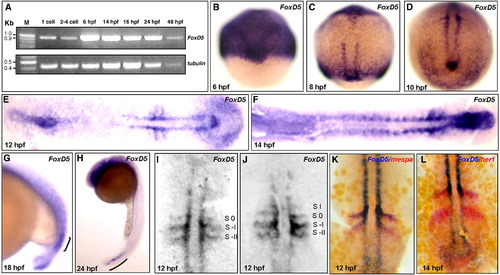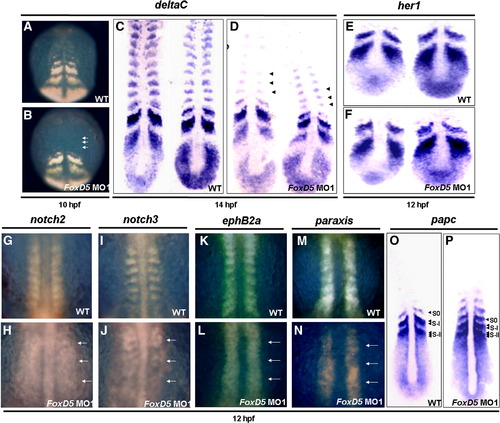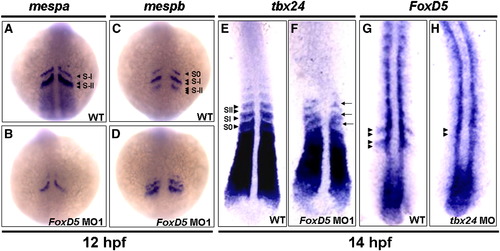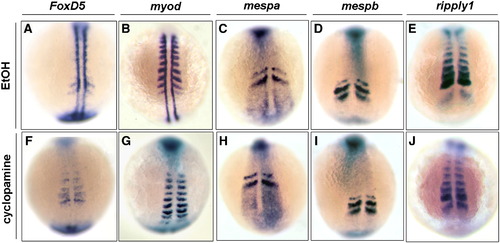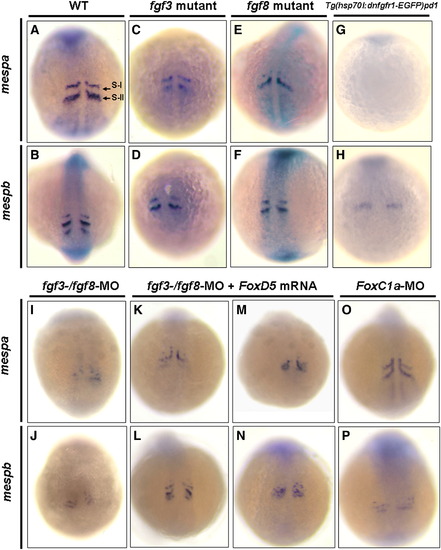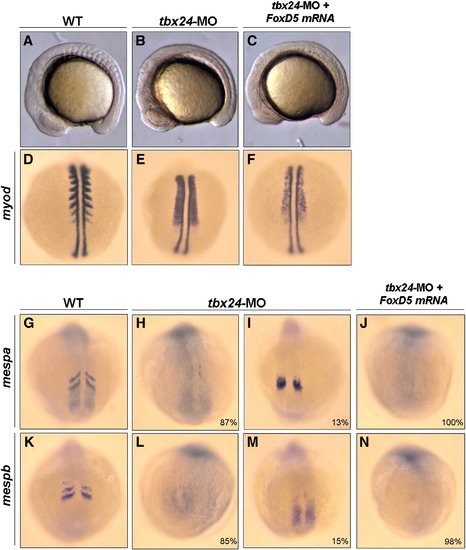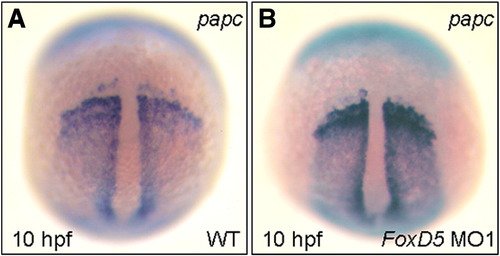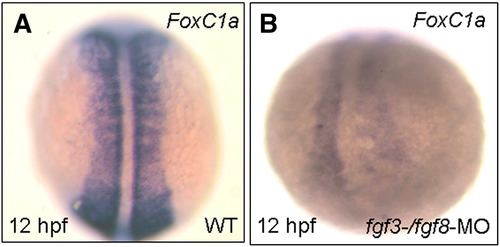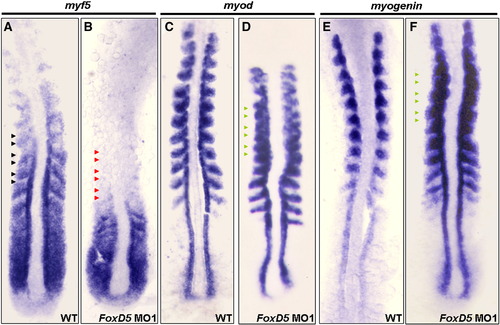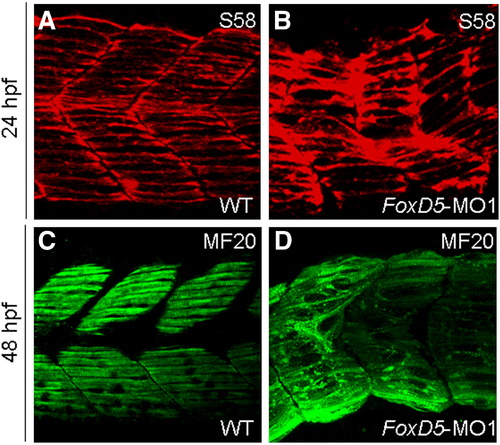- Title
-
FoxD5 mediates anterior-posterior polarity through upstream modulator Fgf signaling during zebrafish somitogenesis
- Authors
- Lee, H.C., Tseng, W.A., Lo, F.Y., Liu, T.M., and Tsai, H.J.
- Source
- Full text @ Dev. Biol.
- Probe
- cb1045 Quality:
- Supplier
|
The spatiotemporal expression of FoxD5 during zebrafish embryogenesis. Using RT-PCR to detect the transcripts of FoxD5 during the developmental stages as indicated. Lane M was a marker, and tubulin was an internal control (A). Using WISH to reveal that FoxD5 was expressed ubiquitously at 6 hpf (B), expressed in the yolk synthetic layer and adaxial cells at 8-hpf (C), and expressed in the anterior PSM, adaxial cells and tailbud at 10- (D) 12- (E) and 14-hpf (F). During 18–24 hpf, FoxD5 in the adaxial cells was down-regulated gradually (black blanket), but it was still expressed in the head and tailbud (G, H). During 12 hpf, dynamic stripe expressions of FoxD5 in the anterior PSM (S0-S-II) and newly formed somites (SI) were observed (I, J). Double ISH of mespa, her1 (labeled in red) and FoxD5 (labeled in blue) expressions during 12 and 14 hpf showed that FoxD5 was expressed in the anterior PSM from S-I to S-II (K, L). |
|
Loss of FoxD5 function resulted in loss of somite polarity during somitogenesis. The FoxD5-MO1-injected embryos with abnormal phenotypes were categorized as having severe defects, such as smaller head size and distortion axis (B), and mild defects, such as reduced head and disordered somites with irregular boundary (C). Dorsal views of trunk somites in WT embryos (WT; D) and FoxD5-MO1-injected embryos (E, F) at 18 hpf. In WT embryos, column-shaped, maturely formed somites (indicated by black arrowheads) and two newly forming somites S-I and S-II (blue arrowheads) were observed. Meanwhile, in FoxD5 morphants, wider and more raggedly formed mature somites (black arrowheads) and newly forming somites, but with irregular somitic furrows (red arrowhead), were observed. The expressions of cb1045 at 18-hpf in WT embryos and FoxD5 morphants were also studied. The cb1045 was specifically observed in the somite borders of WT embryos (G), but it was lost in FoxD5 morphants (H). Co-injection of FoxD5-MO1 and tFoxD5 mRNA enabled embryos to rescue the defective expression of cb1045 induced by FoxD5-MO1 alone (I). In vivo HOM sectioning of WT embryos (J–L) and FoxD5 morphants (M–O) at 24 hpf was examined under bright field (J, M) and dark field microscopes (K, L, N, O). The morphological structures, including skin and somite boundaries, which are labeled in purple, were observed by third harmonic generation signal, whereas muscle fibers, which are labeled in green, were observed by second harmonic generation emissions. Compared to the WT embryos (K, L), the structure of the somites in the FoxD5 morphants was disordered (N, O). EXPRESSION / LABELING:
PHENOTYPE:
|
|
Loss of FoxD5 function did not affect the wavefront and clock in the PSM, but did cause defects in the somites and anterior PSM where the somites were formed. By WISH, the expressions of deltaC, her1, notch2, notch3, ephB2a, paraxis and tbx24, as well as FoxD5 in wild-type embryos (WT), FoxD5 morphants (FoxD5 MO) and tbx24 morphants (tbx24 MO), were observed at 10–14 hpf as indicated. Compared to WT embryos (A, C), FoxD5 morphants showed normal variation in the pattern of deltaC expression, but the striped expression was not maintained in the region where the somites (arrowhead) should have been presented (B, D). The expression of her1 showed a normal oscillation in WT (E) and FoxD5 morphants (F). The striped patterns of notch2, notch3, ephB2a and paraxis in the somites were normal in WT embryos (G, I, K, M), but they were disordered in FoxD5 morphants (H, J, L, N). Expression of papc appeared strongly at somites from S-II to S0. Although the intensity was decreased from posterior to anterior in WT embryos (O), the expression of papc was ectopically increased and showed 5–6 strong signal bands in FoxD5 morphants (P). EXPRESSION / LABELING:
PHENOTYPE:
|
|
Effect of inhibiting FoxD5 protein synthesis on the expression of mespa and mespb. By WISH, the expressions of mespa, mespb and papc in wild-type embryos (WT) and FoxD5 morphants (FoxD5 MO) were observed at 12–24 hpf as indicated. mespa was expressed at somites S-I and S-II in WT (A), but was greatly reduced in FoxD5 morphants (B). mespb was detected from S0 to S-II as a striped pattern in WT (C), but failed to maintain a striped expression (D). Expression of tbx24 was detected in the PSM and the anterior part of formed somites from S0 to SII in WT (arrowheads in E). Although tbx24 expression was unchanged in the PSM, it failed to maintain a segmented expression at the somite region in the FoxD5 morphants (arrows in F). FoxD5 was expressed at tailbud, adaxial cells, and forming somites in WT (arrowheads in G), whereas FoxD5 was still expressed at tailbud and adaxial cells, but was not at the forming somite region in the tbx24 morphants (H). EXPRESSION / LABELING:
|
|
Fgf signaling was necessary for FoxD5 expression during early somitogenesis. Using WISH to detect the expression of FoxD5 and myod in wild-type (WT) embryos, fgf3 mutants, fgf8 mutants, and embryos treated with different materials, as indicated. Embryos were incubated for 6 h in SU5402, starting at 6 hpf; heterozygous strain of fish derived from transgenic line Tg(hsp70l:dnfgfr1-EGFP)pd1 were crossed with WT individuals, and their progeny were heat shocked at 10 hpf for 1 h, followed by WISH analysis at 12 hpf. In both sets of experiments, the expression of FoxD5 in the anterior PSM and adaxial cells was greatly reduced (B, C). In fgf8 (D) and fgf3 mutants (E), the expression of FoxD5 was slightly reduced. However, in fgf3-/fgf8-double-MO-injected embryos, FoxD5 transcripts were almost lost (F). In WT, myod was detected in the somites and adaxial cells (G). While myod could still be detected in the somites and the adaxial cells in fgf3-/fgf8-double-MO-injected embryos (H), it could only be detected in the adaxial cells in embryos treated with SU5402 (I). EXPRESSION / LABELING:
|
|
Hh activity was required for inhibition of FoxD5 expression in the somites. WISH was used to detect the expression of FoxD5, myod, mespa, mespb and ripply1 in control (EtOH) embryos and cyclopamine-treated embryos, as indicated. Embryos were incubated for 6 h in ethanol (A–E) or cyclopamine (F–J), starting at 6 hpf, followed by WISH analysis at 12 hpf. The expression of FoxD5 in the adaxial cells was greatly reduced when Hh activity was inhibited (B). Interestingly, a slightly enhanced and extended expression of FoxD5 in the anterior PSM and somites was observed in cyclopamine-treated embryos (B). In WT embryos, myod was detected in the somites and adaxial cells (C). However, although myod could still be detected in the somites, it was completely lost in the adaxial cells of cyclopamine-treated embryos (D). Both mespa and mespb were normally expressed in control embryos (C, D) and cyclopamine-treated embryos (H, I). The repressor ripply1 was normally detected in control embryos (E) and cyclopamine-treated embryos (J). EXPRESSION / LABELING:
|
|
FoxD5, which was mediated by Fgf signaling, controlled mespa and mespb expressions during somitogenesis. WISH was used to detect mespa and mespb in the wild-type embryos (WT), mutants and embryos injected with different materials as indicated at 12 hpf. Two stripes of mespa expression in the PSM were observable in WT embryos (A), but they were slightly reduced in the fgf3 mutants (C). The mespa signal was lost in S0 in fgf8 mutants (E) and greatly reduced in the heat-shocked embryos derived from transgenic line Tg(hsp70l:dnfgfr1-EGFP)pd1 (G) and in the fgf3-/fgf8-double-MO-injected embryos (I). Three stripes of mespb transcripts were detected in the PSM of WT embryos. Although they were slightly reduced in the fgf3 (D) and fgf8 mutants (F), these three stripes of mespb were greatly lost in the heat-shocked embryos derived from the transgenic line Tg(hsp70l:dnfgfr1-EGFP)pd1 (H) and in the fgf3-/fgf8-double-MO-injected embryos (J). Co-injection of fgf3-/fgf8-double-MO with FoxD5 mRNA enabled embryos to rescue expression of mespa and mespb, but neither the striped pattern of mespa nor that of mespb was restored (K-N). The expression of mespa in the FoxC1a morphants appeared to be unaffected (O), but the expression of mespb in FoxC1a morphants was greatly reduced (P). EXPRESSION / LABELING:
|
|
Excessive FoxD5 mRNA did not enable embryos to rescue the defects caused by tbx24-MO. (A–C) Lateral views of wild-type (WT) and embryos injected with different materials as indicated at 14 hpf. Compared to WT embryos (A), the arrays of the paired somites in tbx24 morphants (B) were lost. Injection of excessive FoxD5 mRNA could not rescue the loss of somite structure induced by the knockdown of tbx24 (C). WISH was performed to detect the expressions of myod, mespa and mespb in WT embryos and in embryos injected with different materials as indicated at 14 hpf. In WT embryos, the segmental expression of myod was detected (D). However, in the embryos injected with tbx24-MO, the segmental expression of myod was lost (E). The defective segmental pattern of myod in tbx24 morphants could not be rescued by injection of FoxD5 mRNA (F). WT embryos showed striped expressions of mespa (G) and mespb (K) in the anterior PSM. The segmental expressions of mespa (H; n = 89, 87%) and mespb (L; n = 68, 85%) were totally abolished in tbx24 morphants. In addition, the scattered expressions of mespa (I; n = 89, 13%) and mespb (M; n = 68, 15%) were also observed in the anterior PSM of tbx24 morphants. Injection of excessive FoxD5 mRNA did not enable embryos to rescue either the striped pattern or the expression levels of mespa (J; n = 47, 100%) and mespb (N; n = 53, 98%) in the tbx24 morphants. EXPRESSION / LABELING:
PHENOTYPE:
|
|
Loss of FoxD5 function resulted in the disorganization of somite furrow formation during somitogenesis. (A-E) Lateral views of wild-type embryos (WT) and embryos injected with different materials as indicated at 16 hpf. Compared to WT embryos (A), the arrays of the paired somites became irregular in the FoxD5-MO1-injected embryos (B) and the FoxD5-/p53-double-MO-injected embryos (C). Embryos displayed a normal phenotype when the tFoxD5 mRNA was co-injected with FoxD5-MO1 (D). No phenotype was observed when we injected 4-8 ng of the control MO (FoxD5 5-mis-MO) which contains five mismatched nucleotides of the corresponding FoxD5-MO1. (A′-E′) Dorsal views of trunk somites in WT and embryos injected with different materials as indicated. WT embryos showed column-shaped, maturely formed somites (A′). Ragged shape of the formed mature somites appeared in the embryos injected with either FoxD5-MO1 alone (B′) or FoxD5-MO1 plus p53-MO (C′). However, the morphological structure of somites appeared unaffected, either in the embryos injected with tFoxD5 mRNA plus FoxD5-MO1 (D′) or in the embryos injected with FoxD5 5-mis control MO (E′). |
|
Injection of FoxD5-MO caused ectopic expression of papc during bud stages. Using WISH to detect papc expression in wild-type embryos (WT) and FoxD5 morphants at 10-hpf. Compared to WT (A), the expression of papc in the anterior PSM was greatly enhanced (B). |
|
Knockdown of Fgf signaling causes lost expression of FoxC1a. Using WISH to detect FoxC1a in wild-type embryos (WT) and fgf3-/fgf8-double-MO-injected embryos at 12-hpf. Compared to WT (A), the expression of FoxC1a was almost lost (B). |
|
Knockdown of FoxD5 reduced myf5 expression, but enhanced myod expression during somitogenesis. The wild-type embryos (WT) and FoxD5-MO-injected embryos at 14-hpf were collected, and WISH was performed with a probe of myf5 (A, B), myod (C, D), and myogenin (E, F). In WT (A), myf5 was expressed in the PSM in a gradient manner from faint intensity at anterior to strong intensity at posterior. In FoxD5 morphants (B), myf5 expression was reduced (red arrowhead), similar to that of WT in the PSM region. However, myf5 was not detected in the somites, as indicated by red arrowhead. In WT (C), myod was expressed at adaxial cells and the posterior part of a somite, but not in somite S-I, as indicated by blue arrowhead. In FoxD5 morphants (D), the myod expression pattern did not change, but the signal intensity was slightly up-regulated. In WT (E), myogenin was expressed at adaxial cells and the forming somites, including those from SI. In FoxD5 morphants (F), myogenin expression was no different from that of WT. |
|
Knockdown of FoxD5 caused the misalignment of myofibrils. The wild-type (WT) and FoxD5-MO-injected embryos at 24- and 48-hpf were collected and subjected to immunochemical staining with antibodies of S58 (Red) and MF20 (green). At 24 hpf, WT embryos exhibited a normal morphology of slow muscles, which revealed a clear arrangement of slow fibers (A). On the other hand, the FoxD5 morphants showed an irregular arrangement of slow muscle fibers (B). At 48 hpf, all muscles were stained by MF20. Normal alignment of myofibrils was observed in WT embryos (C), but misalignment of myofibrils was observed in FoxD5 morphants (D). |
|
Knockdown of either mespa or mespb disrupted somite formation, but the expression of FoxD5 appeared unaffected. (L-F) Lateral views of trunk somites in wild-type embryos (WT) and embryos injected with different materials as indicated. Panels A′-F′ were magnified, and the somite morphology is shown in panels A-F, respectively. Zebrafish WT embryos exhibited normally developed somites at 18-hpf (A and A′). The mespa-MO- (B, B′) and mespb-MO-injected (C and C′) embryos displayed defects in somite formation. Injection of a control MO, mespa-5mis-MO, which contains 5-bp, which are mismatched to the corresponding mespa-MO, resulted in a normal phenotype (D and D′). When embryos were co-injected with either mespa-MO combined with p53-MO (E and E′) or mespb-MO combined with p53-MO (F and F′), the somite structure was still disorganized. Using whole-mount in situ hybridization to detect the expression of FoxD5 in WT (G), mespa (H), and mespb (I) morphants at 12-hpf as indicated. Like WT control embryos (G), the striped pattern of FoxD5 in the anterior PSM was clearly detected in both mespa (H) and mespb (I) morphants. |
Reprinted from Developmental Biology, 336(2), Lee, H.C., Tseng, W.A., Lo, F.Y., Liu, T.M., and Tsai, H.J., FoxD5 mediates anterior-posterior polarity through upstream modulator Fgf signaling during zebrafish somitogenesis, 232-245, Copyright (2009) with permission from Elsevier. Full text @ Dev. Biol.

